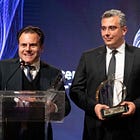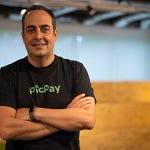This article is part of Fintech Leaders, a newsletter with over 60,000 builders, entrepreneurs, investors, regulators, and students of financial services. I invite you to share and sign up! Also, if you enjoy this conversation, please consider leaving a review on Apple Podcasts, Spotify, or wherever you get your shows so more people can learn from it.
I sat down with Wayne Slavin, CEO & Founder of Sure, a leading insurtech SaaS and infrastructure company powering embedded products for some of the world’s most recognized brands and carriers. They’ve raised over $120m from Menlo Ventures, IA Capital, David Rubenstein’s Declaration Partners, Plug and Play, and many more.
In this episode, we discuss:
How Sure pivoted from a direct-to-consumer model to a B2B embedded insurance provider
“I'm pretty skeptical by nature. So we signed our first client. And it was like, I don't know if this is actually working. It's just one. And then we got our second one. I was like, Okay, maybe this is our thing...”
From Direct-to-Consumer to SaaS Model: Initially, Sure started as a direct-to-consumer mobile app, leveraging Slavin's background in payments. However, they soon realized the limitations of this approach, particularly in terms of marketing and customer engagement. Recognizing their strengths lay elsewhere, they shifted towards a Software as a Service (SaaS) model. This pivot was not a sudden switch but an evolutionary process, where the company continued its original operations while gradually exploring and validating the SaaS opportunity.
Building a Comprehensive InsurTech Platform: Unlike many companies that build front-end solutions on existing banking infrastructure, Sure took on the challenge of developing both the core system and the user interface. This approach meant dealing with the complexities of insurance products, which vary significantly across states and providers. By building a versatile and adaptable platform, Sure positioned itself to quickly onboard various insurance providers.
Evolutionary Approach Rather Than a Sudden Pivot: The shift in Sure's business model was not sudden, but it was an evolutionary process, guided by Slavin's cautious and pragmatic approach. The company did not abandon its original D2C path until the new B2B SaaS model proved viable. This strategy was validated as they acquired multiple clients, confirming the demand for their unique offering.
Why embedded insurance has the potential to revolutionize the industry
“Today, I think 99% of insurance is still offline. And I say offline meaning there's somebody intervening in that process.”
Complex Products in Simple Transactions: The evolution of embedded insurance has gone from simple, add-on products like travel insurance to more complex offerings like home and auto insurance. This shift mirrors the technological advancements seen in AI, where initial basic applications have evolved into sophisticated, multifaceted tools. Sure's approach to embedding insurance products allows consumers to access products seamlessly, integrated into their regular online activities.
Transformation of the Insurance Industry: Wayne envisions a future where the next big insurance company won't be an insurance company in the traditional sense. Instead, it will be a platform that enables various brands and businesses to offer insurance products directly to their customers. This shift is akin to the fintech revolution, where financial services became accessible through non-financial companies. By embedding insurance into various customer journeys, companies with large customer bases can offer relevant, necessary insurance products, enhancing their value proposition and customer loyalty.
Offline to Online Evolution in Insurance: Drawing parallels with the early days of credit cards and the development of Visa's infrastructure, Slavin points out that the insurance industry is still predominantly offline, with personal intervention required in most transactions. He sees a massive opportunity in digitizing the insurance process, akin to the transformation seen in the financial sector with the advent of digital transactions.
Seeking mentors strategically and learning from both good and bad managers.
“I felt more pain and frustration from bad managers. But I'd say the things that I learned from the good managers like loyalty and authenticity, are where I spend much more of my time.”
Wayne's approach to finding mentors became more strategic during his time at Columbia Graduate School. The program he attended matched students with Fortune 500 CIOs, CTOs, and Innovation Officers, providing a unique opportunity to connect with high-level executives. Perhaps the most strategic move in his mentorship journey was his decision to tailor his research thesis to attract the type of mentor he desired. By focusing on cybersecurity in the context of big banks, he cast a targeted "fishing line" into a pool of potential mentors with expertise in this area. This approach landed him a superstar mentor with a great background including leadership roles in banking and FinTech entrepreneurship.
Why you cannot outcompete the immigrant drive and hustle mindset in business… and a lot more!
“If you were to really try and distill down the immigrant mindset, it's like, hey, I gotta go do this. Nobody's gonna let me do it. Nobody's gonna give me permission to do it. So I have the permission to do it.”
"Ask for Forgiveness, Not Permission" Approach: Central to the immigrant hustle is a proactive and bold attitude. Immigrants often operate under the principle of taking action first and seeking approval later, if at all. This mindset stems from the necessity of navigating new environments where opportunities are not readily handed out. It's a survival strategy turned into a business tactic: act now, because waiting for permission could mean missing out on crucial opportunities. This approach is particularly effective in the tech industry, where speed and innovation are key, and waiting for approval can mean falling behind.
Thriving Across Cultures and Industries: The immigrant hustle is not confined to a single culture or industry. Slavin observes that certain cultures embody this mindset more naturally and, as a result, thrive in various business sectors, including technology. This universal aspect of the immigrant hustle suggests that it's less about specific skills and more about a general attitude toward life and business. It's about the relentless pursuit of success against all odds, a trait that is invaluable in the unpredictable and competitive world of startups.
Episode Chapters
00:00 Introduction and Background
04:13 Early Entrepreneurship Journey
07:55 Seeking Mentors and Learning from Managers
09:45 Transition to Sure and Pivoting to B2B
14:38 Lessons from Previous Experiences
19:49 Evolution of Sure's Business Model
25:39 Making the Shift to Embedded Insurance
29:30 The Future of Embedded Insurance
36:38 The Immigrant Drive and Hustle Mindset
40:00 How Listeners Can Reach out
Want more podcast episodes? Join me and follow Fintech Leaders today on Apple, Spotify, or your favorite podcast app for weekly conversations with today’s global leaders that will dominate the 21st century in fintech, business, and beyond.
Previous Episodes You May Enjoy:
Video Highlights You Will Definitely Like:
Miguel Armaza is Co-Founder & General Partner of Gilgamesh Ventures, a seed-stage investment fund focused on fintech in the Americas. He also hosts and writes the Fintech Leaders podcast and newsletter.


























Share this post